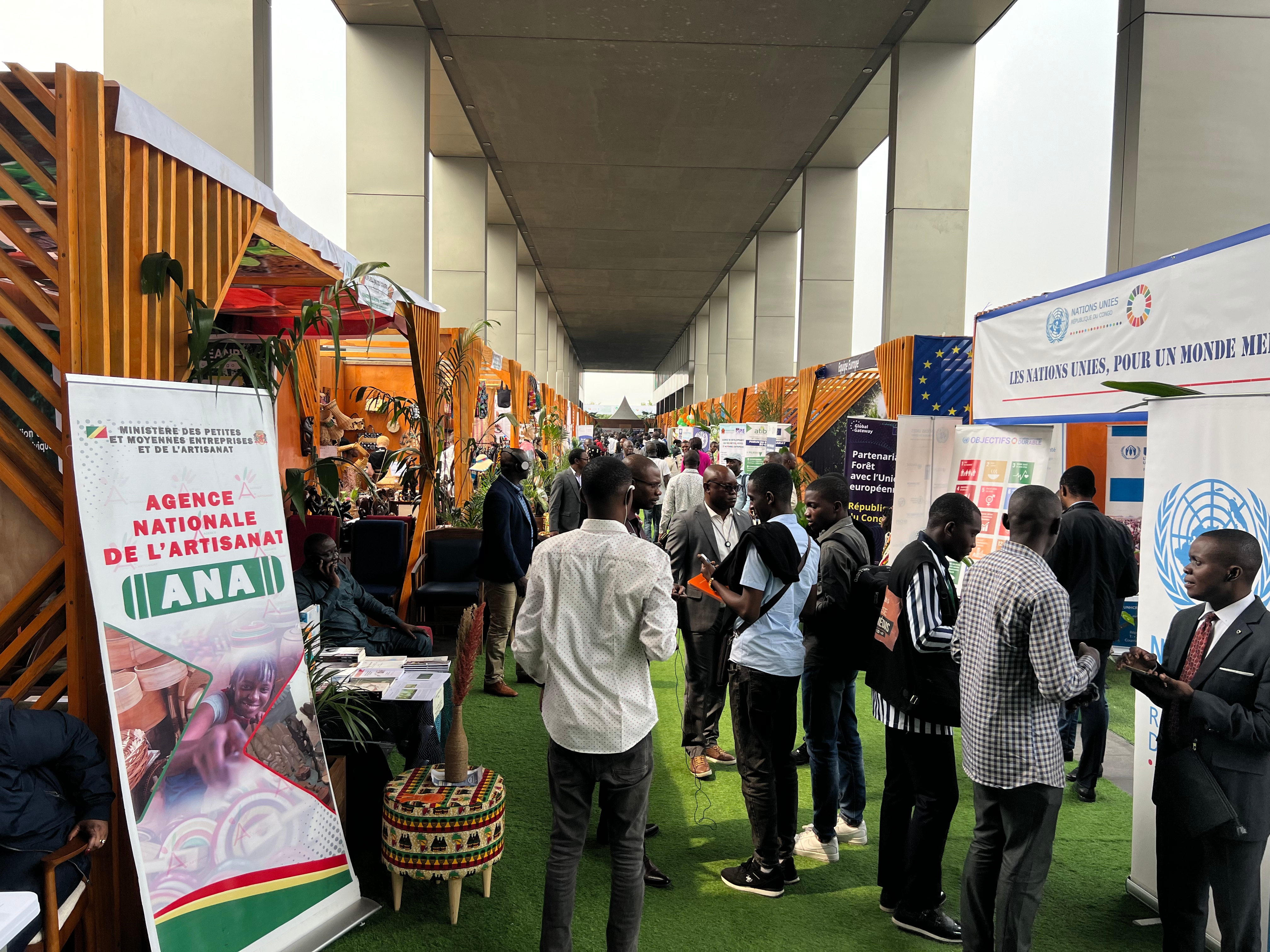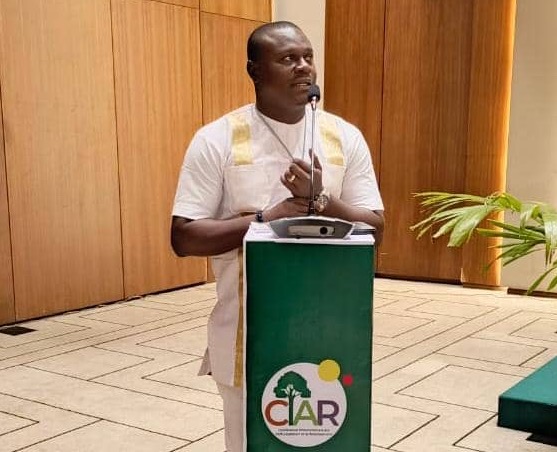

12.07.2024
The first International Conference on Afforestation and Reforestation (ICAR1) was successfully held in Brazzaville between July 2 and 5, 2024. It brought together global experts, policy-makers and industry representatives to discuss the challenges and opportunities associated with afforestation and reforestation. This crucial event highlighted the urgent need for new plantations to meet the growing demand for wood and the need to protect existing natural forests.
ATIBT took part in the meeting to present the results of the UFA-Reforest project financed by the European Union in Cameroon.

This first CIAR conference is a COP 27 initiative within the framework of the African and Global Decade of Afforestation and Reforestation (DAMAR).
One of the objectives is to seek the inclusion of the "African and Global Decade of Afforestation" in the United Nations Agenda in September 2024, by means of a global declaration on afforestation and reforestation.
Within the framework of DAMAR, it was necessary to create scientific content and obtain a political consensus around a set of strategic axes enabling the deployment of ambitious Afforestation and Reforestation programs worldwide.
An international committee of member countries of the United Nations has been set up, and ICAR1 is part of this dynamic.
More information on the conference
Opening conference
The REPAR and RAPALEAC organizations were invited to speak at the start of the conference, to underline the importance of involving indigenous peoples in reforestation initiatives, to limit deforestation by launching a vast planting program with a choice of species that would be a source of motivation for indigenous populations, as they are rich in virtues and properties that are useful to them.
As a reminder, at COP27, several replanting commitments were made for Africa. Notably, Kenya aims to achieve a target of 15 billion trees by 2030, focusing not only on planting, but also on monitoring their growth to maturity. In addition, Nigeria has launched the "250k" project, which involves the commitment of 250,000 young people to plant 250,000 trees across the country, as part of an effort to involve young people in climate action and raise their awareness of environmental issues.
The private sector also expressed its views, through UNICONGO. Businesses can provide resources and concrete solutions to encourage the development of projects such as the "green wall", or the Rwanda project, in which local populations were involved. Projects in the Congo were also mentioned, such as the one carried out on the Batéké Plateaux under the direction of FRMi, and on behalf of Total. Worker training is also a key factor, and the employer is committed to this.
The UNDP representative in Congo pointed out that the world loses 10 million hectares of natural forest every year, an area the size of Portugal. In Africa, some 3.9 million hectares of forest are lost every year. This loss is mainly due to the conversion of forests to agricultural land to meet the needs of a growing population, and to the extraction of wood for charcoal production. Agricultural practices such as shifting cultivation, involving the cutting and burning of forests to create farmland, are major causes of this deforestation.
The main obstacle to deforestation is the lack of financial resources.
The FAO has compared these deforestation figures with the increase in the world's population. The knowledge exists to implement a program to tackle the multiple challenges that exist.
WWF has indicated that it expects a more concrete roadmap for the future from the ICAR1 conference.
CEEAC sees this conference as an opportunity to implement the international strategy on afforestation and reforestation at regional and national level, in synergy with business development.
The opening session closed with a speech by H.E. the Minister for Forest Economy, who reminded us that "trees are an essential tool in the fight against climate change". Climate change has immediate consequences in terms of extreme climatic events such as forest fires and floods, but also other, more pernicious consequences such as desertification, rising sea levels, the increasing scarcity of certain resources, and so on.
Forest management, certification, reduced-impact logging and conservation are also responses to the growing demand for wood.
Madame Minister recalled that since the 1980s, the Republic of Congo has been committed to reforestation. This year, the Republic of Congo will celebrate the 39th anniversary of National Tree Day.

Key topics discussed at the conference
Surface area and production: urgent needs
The conference highlighted that of the world's 4 billion hectares of forests, only 260 million hectares are plantations, with 150 million hectares intensively managed. Between 2015 and 2020, the world suffered a net deforestation of 5 million hectares per year (taking into account the approximately 5 million hectares planted annually worldwide), with a particularly marked loss in Africa, reaching 3.9 million hectares annually. Despite growing demand, there is a tendency to restrict production from natural forests, making the development of new plantations imperative and urgent. Forecasts indicate that at least 40 million additional hectares will be needed to meet demand for timber, in addition to the 30 million hectares required in Africa for wood energy.
An expanding wood market
Population and economic growth, as well as the decarbonization of economies, are driving demand for roundwood and wood energy, with projected increases of 40% and 30% respectively by 2050. New uses for wood, notably in construction, chemicals and bioenergy, are developing rapidly. The market for carbon credits, essential to companies' carbon neutrality policies, is growing exponentially, from $2 billion in 2021 to projections of between $25 and $250 billion by 2030, according to various forecasts. This emerging market, although not yet harmonized, represents a major opportunity for Africa, thanks to its vast land reserves.
Financing and investments
The financial requirements to support afforestation and reforestation efforts are enormous, estimated at between $200 and $300 billion for 40 million hectares. International institutions, regional development agencies and commercial banks are mobilizing to create innovative financing mechanisms. The private sector is also heavily involved, with major corporations and investment funds already financing large-scale natural carbon sink projects in Africa.
Afforestation and reforestation models: towards socio-economic and environmental integration
Afforestation and reforestation models are evolving towards more integrated approaches, combining forest plantations and agroforestry, and taking account of social and environmental imperatives. These initiatives represent a powerful lever for development in rural areas, integrating agricultural practices and moving towards agroecology. The need for expertise and technology to implement these projects underlines the importance of research and development.
The results of numerous projects were presented at round tables and stands.
The First International Conference on Afforestation and Reforestation organized a number of round tables, grouped by main themes. This summary highlights the key themes discussed at the round tables, reflecting CIAR's multi-dimensional efforts to promote afforestation and reforestation through technological innovation, community inclusion, sustainable financing, and international cooperation.
Various experiences and work relating to afforestation and reforestation were presented using visual aids (mini videos, photos, kakemonos, flyers, etc.) at the exhibition stands.

Various ATIBT members and partners, including CIRAD, FRMi, IFO, Olam, Rougier, ITTO, FAO, ERAIFT, WWF, WRI, CIFOR-ICRAF, led or took part in panels or round tables.
Discussions on the implementation of bioenergy in rural areas, the role of research in afforestation and reforestation (particularly on new silvicultural models for the carbon and plantation timber sectors), the use of geospatial technologies to improve forest plantations and agroforestry systems, and geospatial monitoring for effective forest management.
Focus on agroforestry solutions for local and indigenous communities, the importance of forests for indigenous peoples, agroforestry practices and their impact on greenhouse gases, and community involvement in reforestation activities in the DRC.
Exploring climate financing opportunities for reforestation programs, the importance of carbon credits as a financing tool, and increasing international financial flows for high-integrity forests in the Congo Basin.
Presentations of specific projects such as SNPC's Eco Zamba Project operated by FRMi, biochar, reforestation opportunities for entrepreneurship and youth employment, and the signing of agreements between the Congolese state and various private partners.
2 round tables were organized by ATIBT, based on results obtained under the UFA-Reforest project in Cameroon:


This UFA-Reforest project was financed by the European Union through its Cameroon delegation, as part of the 11ème EDF. Initiated almost 3 years ago, this project now appears particularly innovative and pioneering, given the importance of reforestation issues in Africa.
Signing of several agreements and protocols between the Congolese government, companies and international organizations to promote afforestation and reforestation initiatives.
Analysis of the ecological impacts of FSC certification, monitoring of long-term plantations in Cameroon, and lessons learned from 40 years of reforestation in the DRC.
Several international and national civil society organizations and companies involved in afforestation and reforestation, as well as forest restoration, set up exhibition stands to showcase their achievements and current projects.
Kakemonos and flyers from ATIBT, the ASP Congo project and the UFA Reforest Cameroun project were displayed at the European Union stand, prompting questions from conference participants.
ATIBT's member forestry companies, notably CIB OLAM, IFO and FRMi, also organized exhibitions at their stands.
Outlook and recommendations : Africa in the lead
Central Africa is positioning itself as a leader in the deployment of afforestation and reforestation programs, with a target of quadrupling afforested areas over the next ten years. The global afforestation and reforestation strategy comes at a crucial time, aligned with global efforts to combat climate change, decarbonize economies and develop wood-based sectors and agroforestry.
Several ministers presented the commitments of their countries, including Angola, Burundi, the Democratic Republic of Congo, the Republic of Congo, Gabon, the Central African Republic, Niger, Chad, Rwanda, Ghana and Côte d'Ivoire.
They insisted, among other things, on :
Paul Bertaux of FRMi summarized the experts' recommendations. The conference's 7 recommendations were as follows:
1-Strengthen international cooperation: Encourage greater collaboration between nations and initiatives to share best practices and technologies.
2-Implement policies and regulatory frameworks: Develop regional and national policies favoring afforestation and reforestation, including tax incentives and robust regulatory frameworks.
3-Support sustainable and innovative financing: Mobilize large-scale financing, including carbon finance, public-private partnerships (PPPs), payments for environmental services and other green financing.
4-Involve local communities and indigenous peoples: Include local communities and indigenous peoples in reforestation projects, providing them with the necessary resources and the best planting techniques.
5-Promote nature-based solutions: Encourage forest plantations, agroforestry and other natural and affordable solutions as alternatives to the production of goods and services, wood energy and industrial wood.
6-Monitor and evaluate progress: Set up rigorous national, regional and global systems to monitor progress.
7-Introduce a "DAMAR" honorary distinction: Create an honorary distinction to reward a country, organization or individual who has made a significant contribution to afforestation, reforestation and the fight against deforestation.
ATIBT will provide further information on the follow-up to this conference, and a detailed article on the ATIBT round tables will be produced shortly.